Stress Relief Program
🢂 Abhyanga ( Massage)
🢂 Shiro Dhara
🢂 Tarpana / Nasya
🢂 Therapeutic Yoga
Note : Left Scroll and Right Scroll
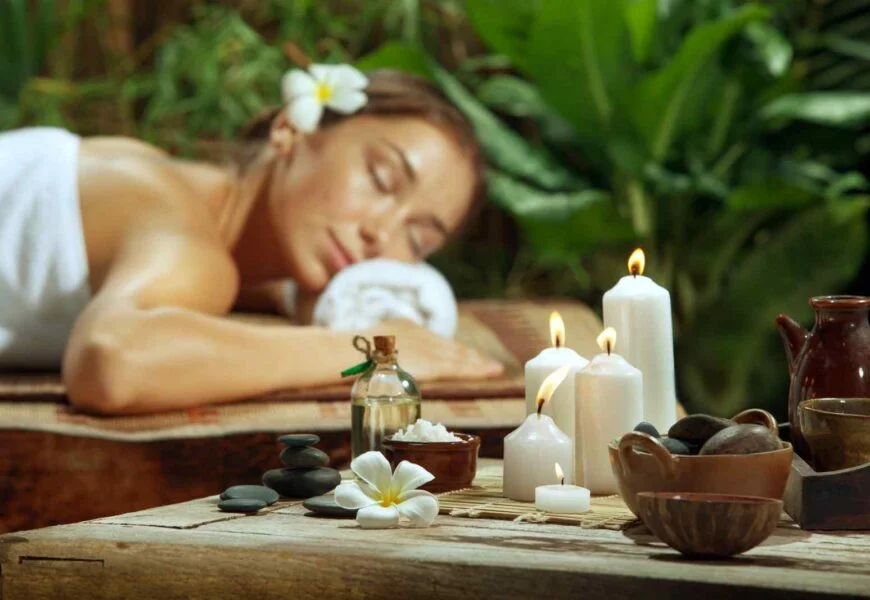

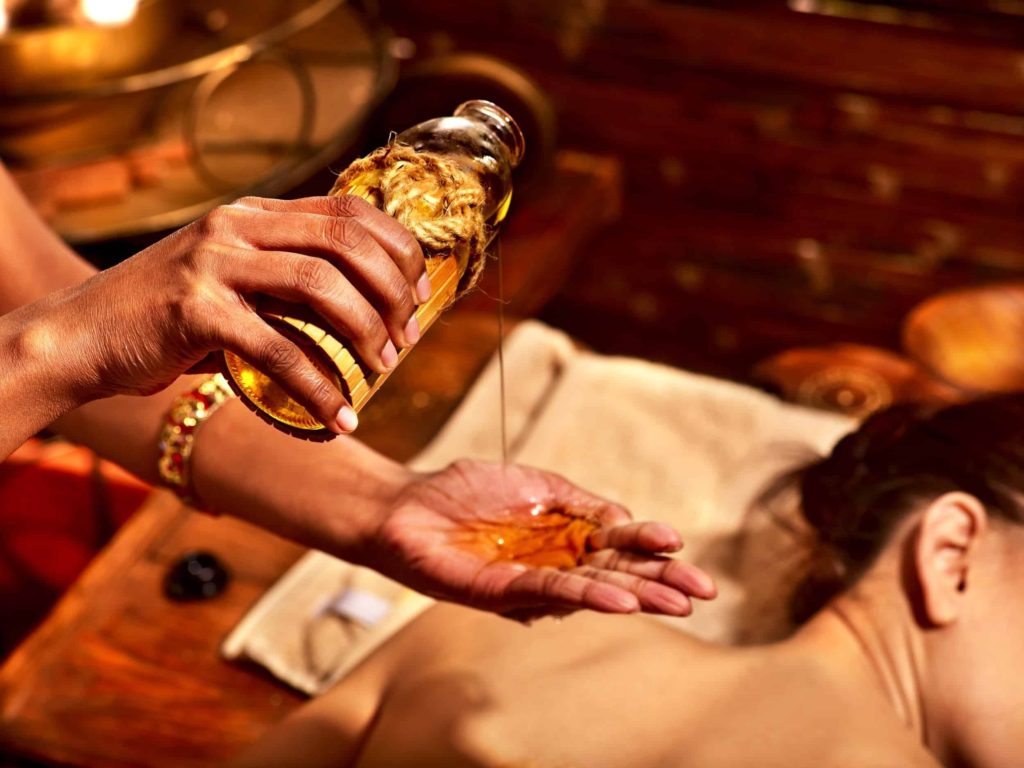
Abhyanga, an integral component of Ayurvedic healing, is a traditional massage technique that holds profound therapeutic significance. Derived from the Sanskrit words ‘abhi’ meaning ‘towards’ and ‘anga’ referring to ‘limbs,’ Abhyanga involves the rhythmic and synchronized application of warm herbal oils on the entire body.
This Ayurvedic massage serves multiple purposes, aiming to promote physical, mental, and spiritual well-being. The choice of oils is often determined by an individual’s dosha (Vata, Pitta, or Kapha) and specific health needs. The massage technique involves gentle yet firm strokes, stimulating energy channels (marma points) to enhance circulation, lymphatic drainage, and overall vitality.
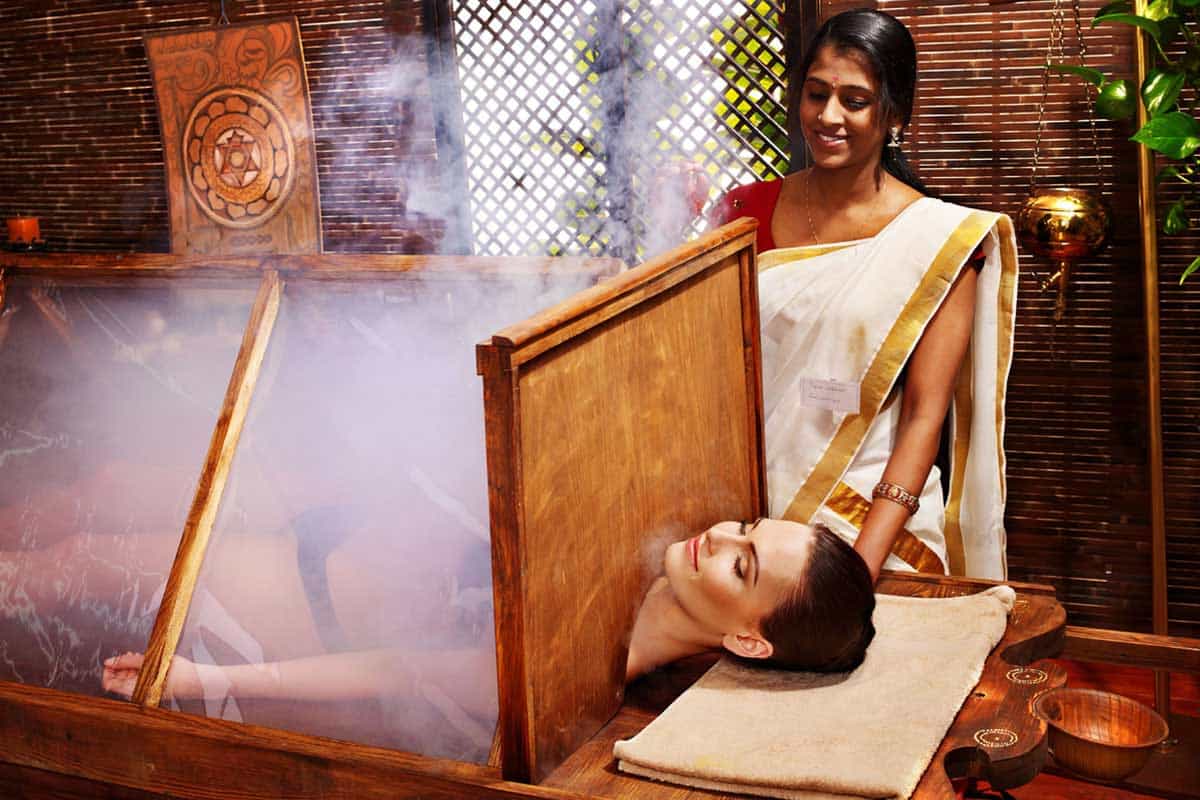
Kizhi, a therapeutic practice in Ayurveda, involves the application of heated herbal poultices to the body. These poultices, known as “Kizhi,” are typically filled with a blend of medicinal herbs, rice, or other beneficial substances. The poultices are dipped in warm, herbal oils and then rhythmically massaged or patted onto the body. This treatment aims to induce sweating, promote circulation, and alleviate various musculoskeletal conditions. Additionally, steam baths, another integral aspect of Ayurveda, involve exposure to herbal steam to purify the body, enhance skin health, and eliminate toxins. Both Kizhi and steam baths contribute to the holistic healing philosophy of Ayurveda.
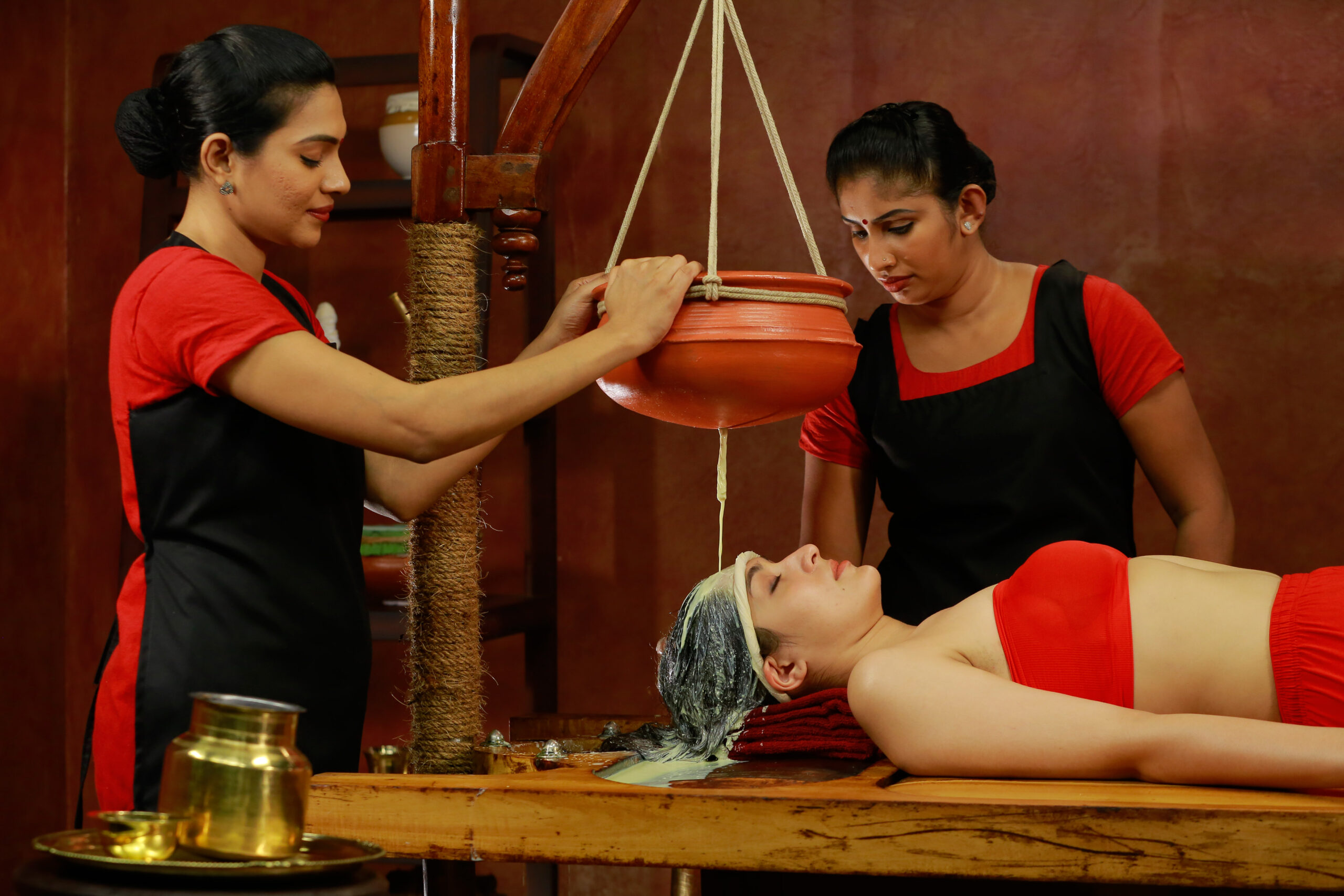
Shiro Dhara is a prominent Ayurvedic therapy involving a continuous stream of warm herbal oil, medicated milk, or other liquids poured onto the forehead (shiro) in a steady, rhythmic flow. This therapeutic technique induces deep relaxation by targeting the “third eye” area, believed to balance and calm the mind. The continuous flow stimulates the pineal gland, promoting mental clarity and reducing stress. Shiro Dhara is renowned for alleviating conditions like insomnia, anxiety, and migraines. The soothing effect on the nervous system and the profound impact on mental well-being make Shiro Dhara a cherished practice in Ayurveda for achieving harmony between the body and mind.
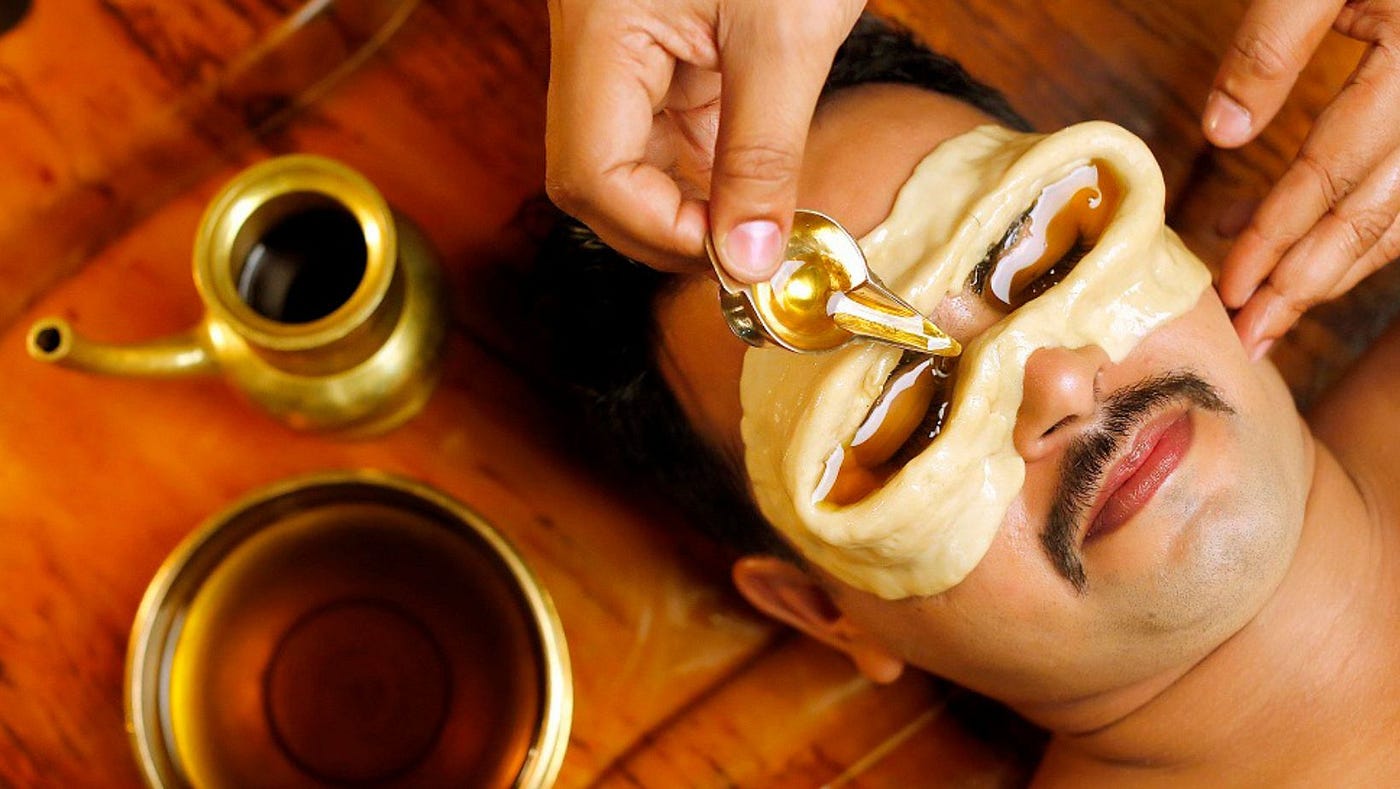
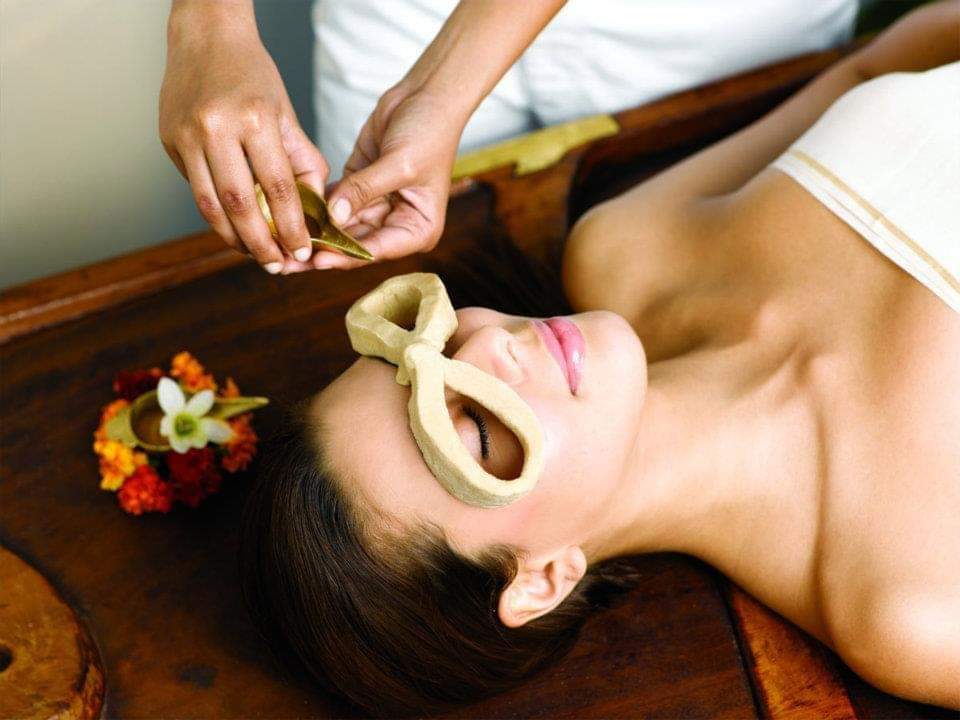
Panchakarma is a comprehensive and ancient Ayurvedic therapeutic process designed to purify and rejuvenate the body, mind, and spirit. Consisting of five main cleansing procedures, Panchakarma addresses imbalances in the doshas (Vata, Pitta, Kapha) and eliminates accumulated toxins (ama). These procedures include Vamana (emesis), Virechana (purgation), Basti (enema), Nasya (nasal administration), and Rakta Mokshana (bloodletting). Panchakarma aims to restore optimal health by detoxifying and rejuvenating various bodily systems. It is a holistic approach that promotes harmony, vitality, and balance, with individualized treatment plans tailored to each person’s unique constitution and health needs.
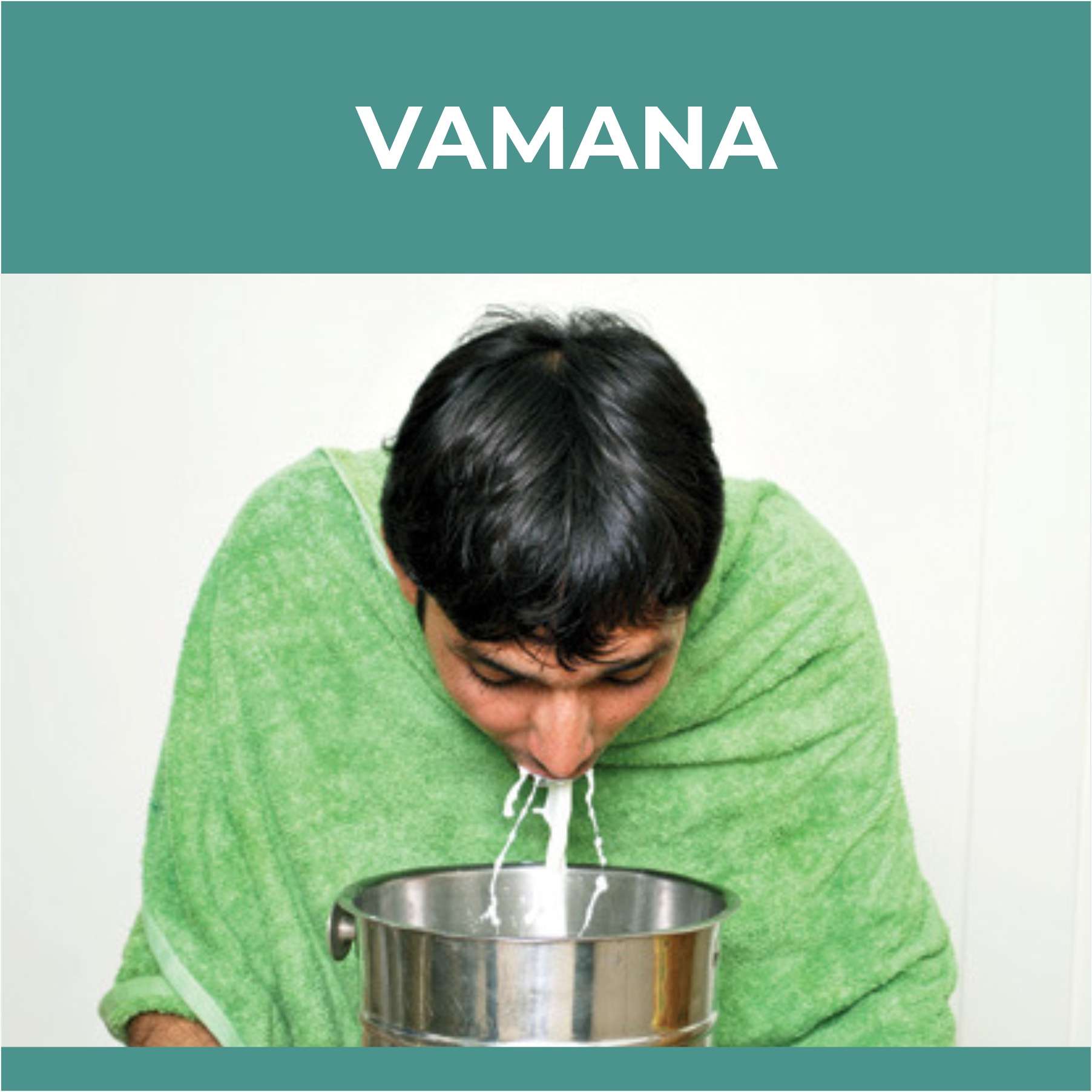
Vamana, a key therapeutic process in Ayurveda, is a purification technique aimed at balancing the Kapha dosha. This procedure involves the controlled induction of therapeutic vomiting to expel excess mucus and toxins from the stomach and respiratory system. Before Vamana, individuals undergo a preparatory phase, including internal oleation and external oil applications.
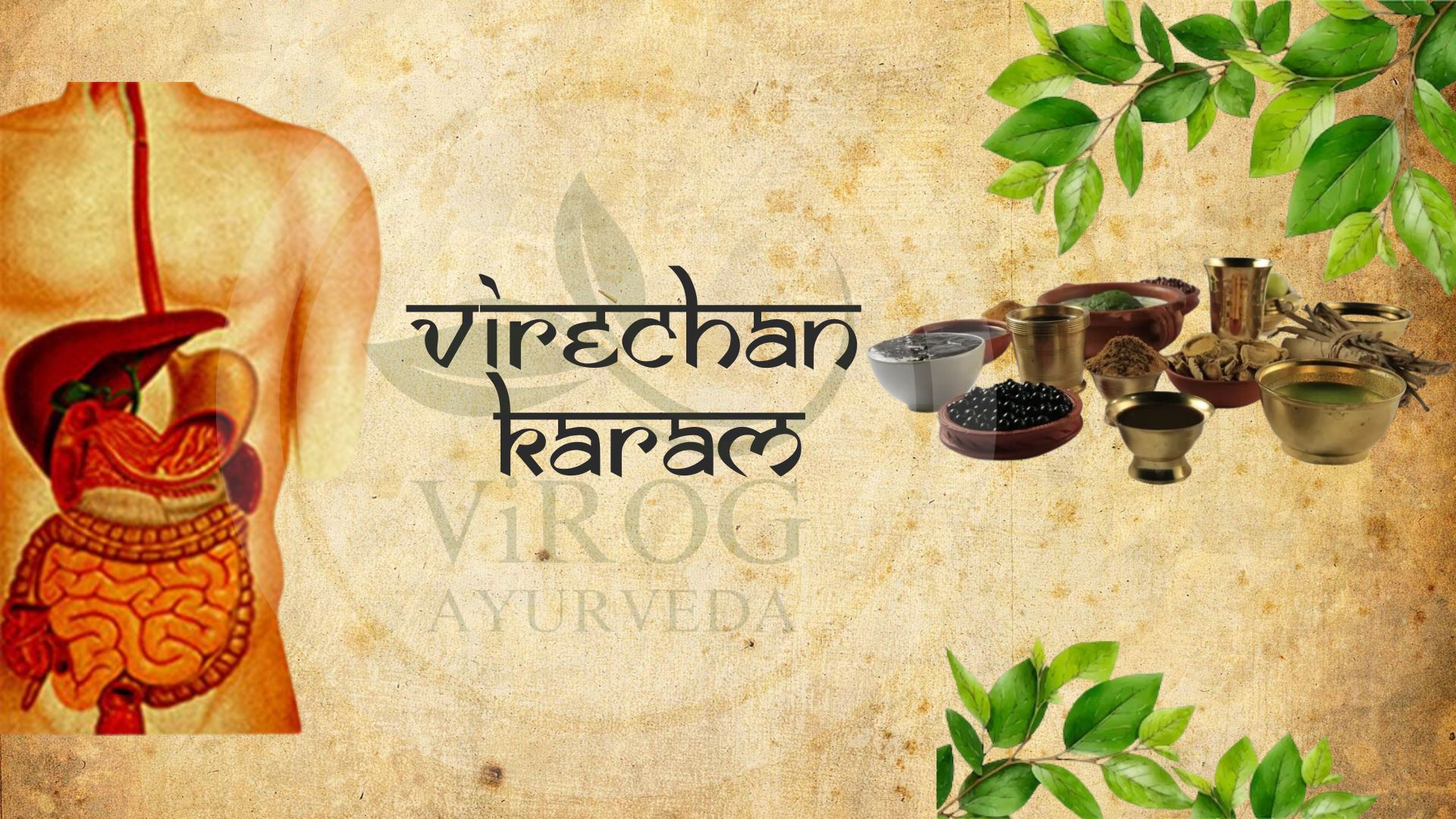
Viracharna, a vital aspect of Ayurveda, embodies the therapeutic purification process aimed at eliminating toxins from the body. Rooted in the Sanskrit words ‘Vira’ (poison) and ‘Charana’ (removal), Viracharna is a specialized detoxification therapy. This Ayurvedic service employs medicated powders, herbs, and oils to expel accumulated impurities and restore balance in bodily functions. It plays a pivotal role in preventing diseases and promoting overall well-being by addressing the root cause of imbalances. Through meticulous cleansing, Viracharna enhances digestion, boosts immunity, and revitalizes the body. Ayurveda, with Viracharna as a cornerstone, emphasizes the profound connection between physical and mental health, offering a holistic approach to wellness.
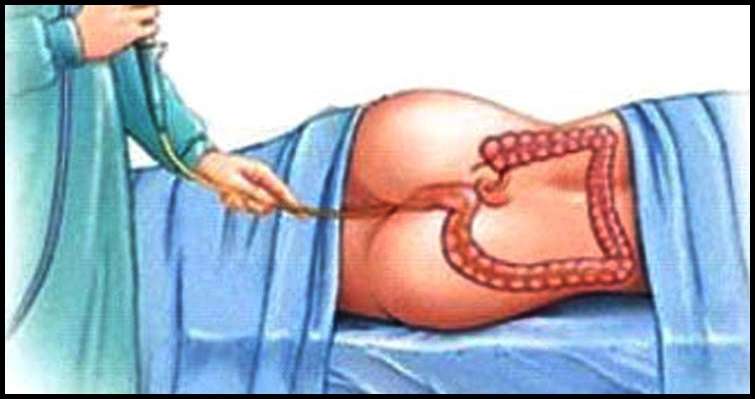
Vasti, a prominent Ayurvedic therapy, involves the administration of medicated substances through the rectum to eliminate toxins and restore balance in the body. Derived from the Sanskrit word ‘Vasti,’ meaning bladder or pouch, this therapeutic enema is a cornerstone of Panchakarma, the Ayurvedic detoxification process. Vasti employs herbal decoctions, oils, and other substances tailored to an individual’s constitution, aiming to cleanse the colon, enhance digestive functions, and alleviate various ailments. This ancient practice not only purifies the body but also contributes to mental clarity and overall well-being, aligning with Ayurveda’s holistic approach to health and longevity.
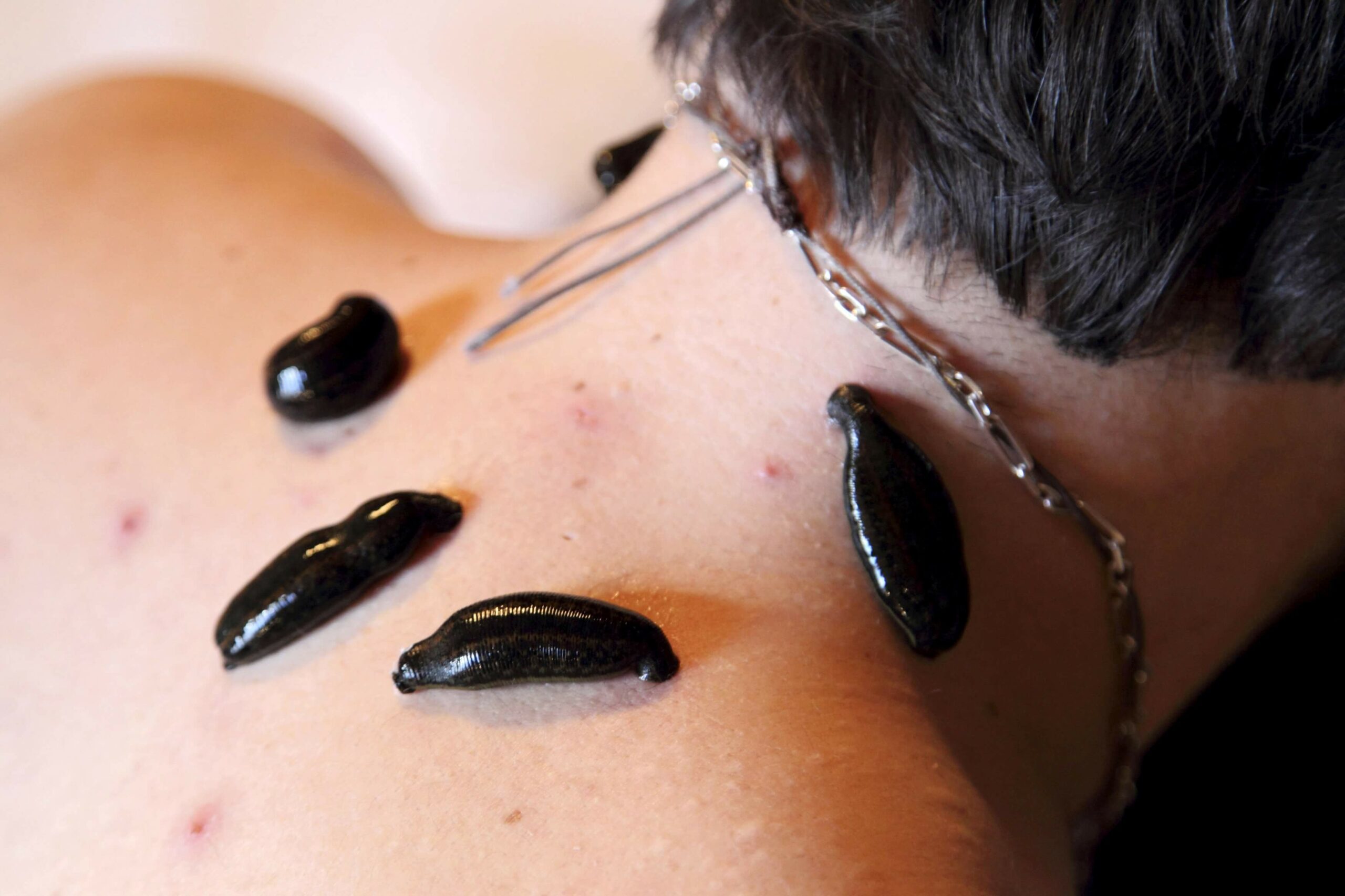
Raktamokshana, an integral Ayurvedic therapy, focuses on purifying the blood to maintain health and prevent diseases. Derived from Sanskrit, where ‘Rakta’ means blood and ‘Mokshana’ means letting go or releasing, this treatment involves controlled removal of a small quantity of blood to eliminate impurities. Raktamokshana is considered a vital component of Panchakarma, the Ayurvedic detoxification process. Various methods, such as venesection (bloodletting) and leech therapy, are employed to cleanse the circulatory system, improve circulation, and address conditions related to impure blood. This ancient practice highlights Ayurveda’s holistic approach, aiming to restore balance and promote overall well-being.


Abhyanga, an integral component of Ayurvedic healing, is a traditional massage technique that holds profound therapeutic significance. Derived from the Sanskrit words ‘abhi’ meaning ‘towards’ and ‘anga’ referring to ‘limbs,’ Abhyanga involves the rhythmic and synchronized application of warm herbal oils on the entire body.
This Ayurvedic massage serves multiple purposes, aiming to promote physical, mental, and spiritual well-being. The choice of oils is often determined by an individual’s dosha (Vata, Pitta, or Kapha) and specific health needs. The massage technique involves gentle yet firm strokes, stimulating energy channels (marma points) to enhance circulation, lymphatic drainage, and overall vitality.
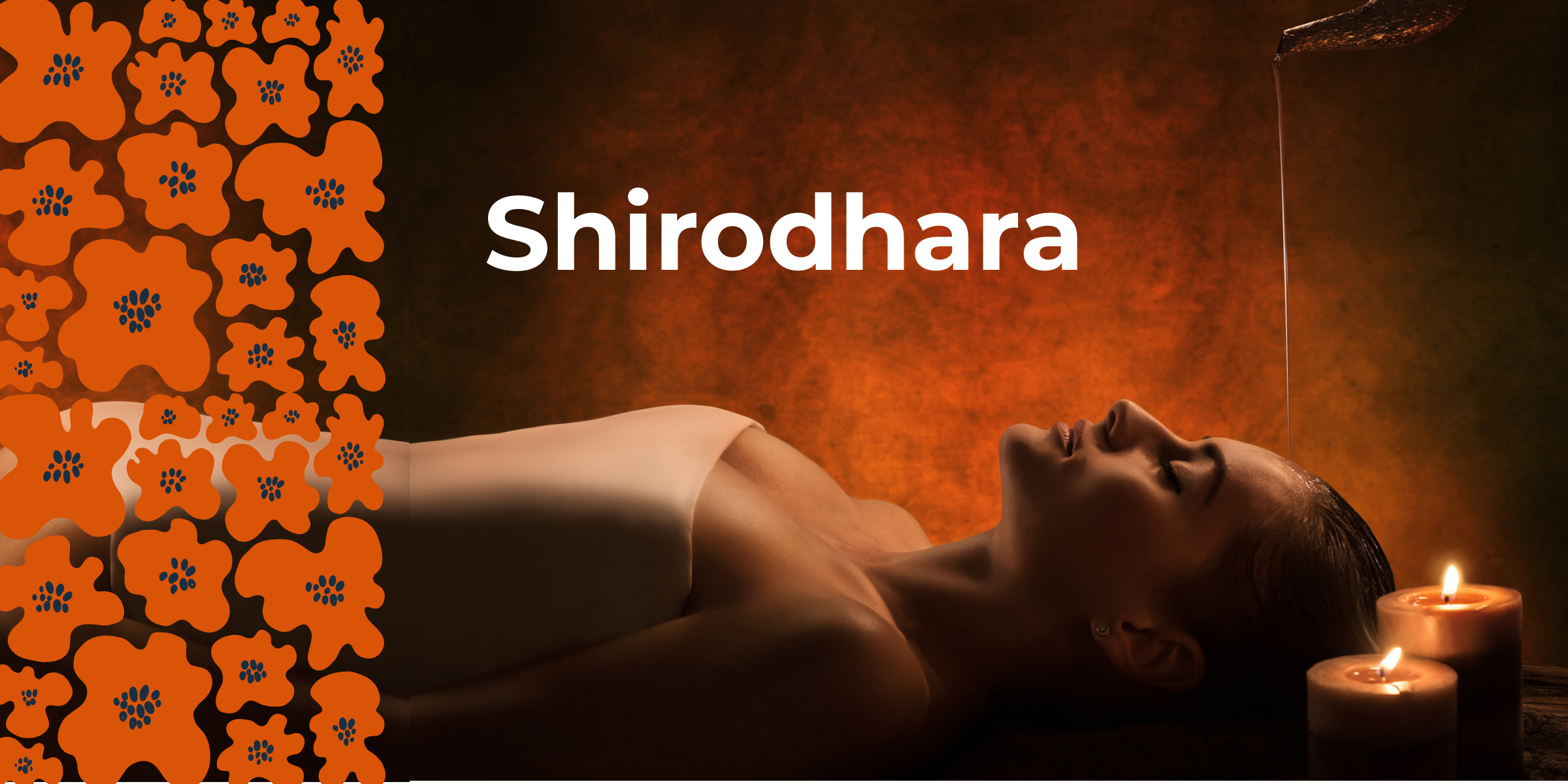
Shirodhara, a quintessential Ayurvedic therapy, involves a continuous stream of warm, herbal oil gently poured onto the forehead, specifically on the ‘third eye’ region. Derived from Sanskrit, where ‘Shiro’ means head and ‘Dhara’ means flow, this soothing treatment induces profound relaxation, balancing the nervous system. The rhythmic flow of oil stimulates the pineal gland, promoting mental clarity and tranquility. Shirodhara is renowned for alleviating stress, anxiety, and insomnia. Beyond its therapeutic benefits, this ancient practice fosters a deep sense of calm, aiding in overall well-being. Shirodhara exemplifies Ayurveda’s holistic approach to health by harmonizing mind, body, and spirit.

Tarpana and Nasya are two distinct yet interconnected Ayurvedic therapies. Tarpana involves rejuvenating the eyes with herbal ghee, alleviating eye strain, and improving vision. Derived from Sanskrit, where ‘Tarpayati’ means to nourish, Tarpana promotes ocular health by balancing doshas. On the other hand, Nasya involves the administration of medicated oils or herbal substances through the nostrils. This nasal therapy, derived from ‘Nasa’ meaning nose, addresses sinus issues, enhances mental clarity, and detoxifies the head region. Both Tarpana and Nasya exemplify Ayurveda’s tailored and holistic approach, aiming to restore balance in specific areas, contributing to overall well-being
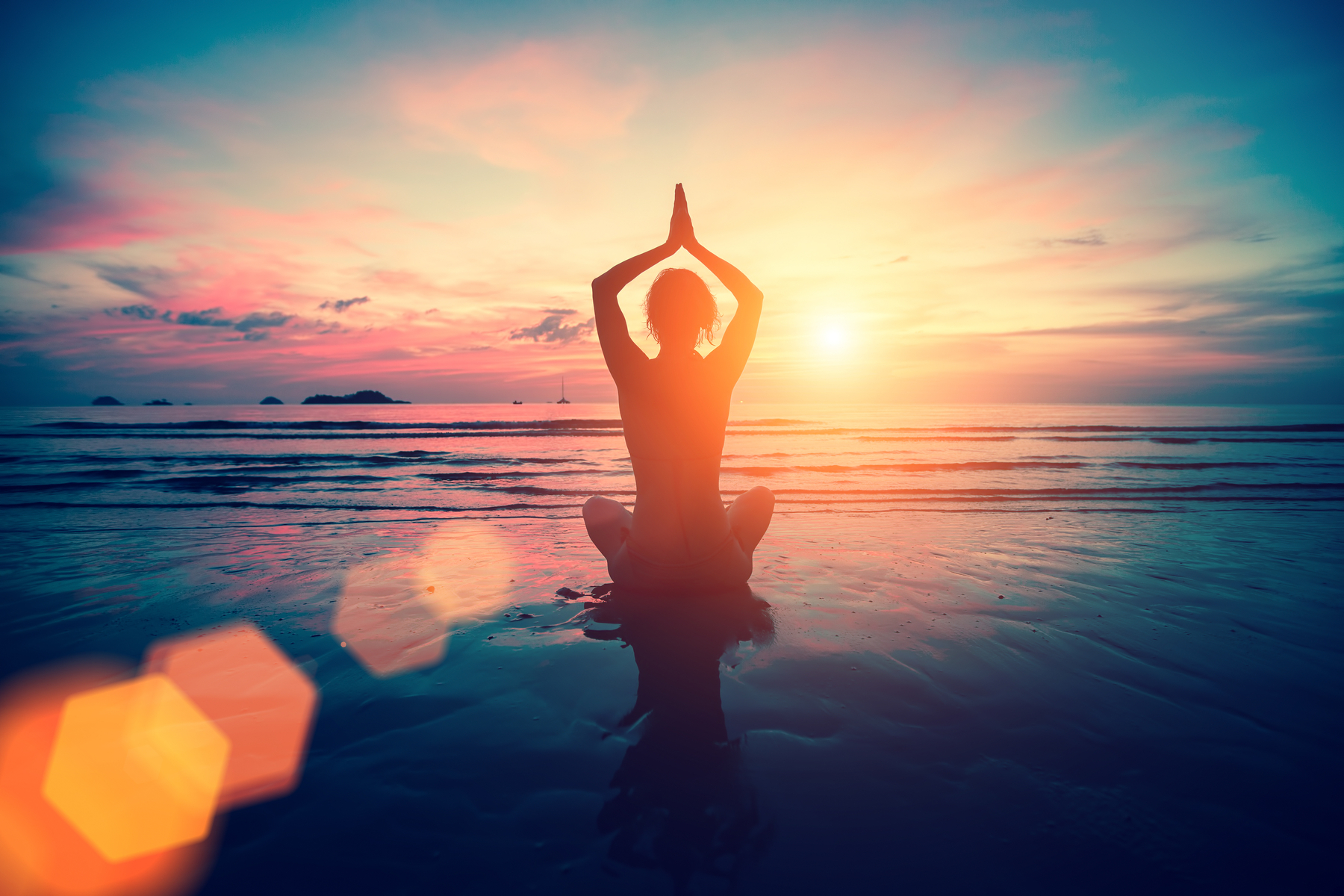
Therapeutic Yoga within Ayurveda integrates the principles of both systems to address specific health concerns. This personalized practice involves a combination of asanas (postures), pranayama (breath control), and meditation, tailored to an individual’s unique constitution and imbalances. It focuses on promoting physical and mental well-being, addressing specific health issues such as stress, anxiety, and chronic conditions. Therapeutic Yoga in Ayurveda emphasizes the importance of balance and harmony in one’s daily life, aiming to restore vitality and enhance overall health. This integrative approach reflects the synergy between Ayurveda and Yoga, working together to optimize holistic well-being.
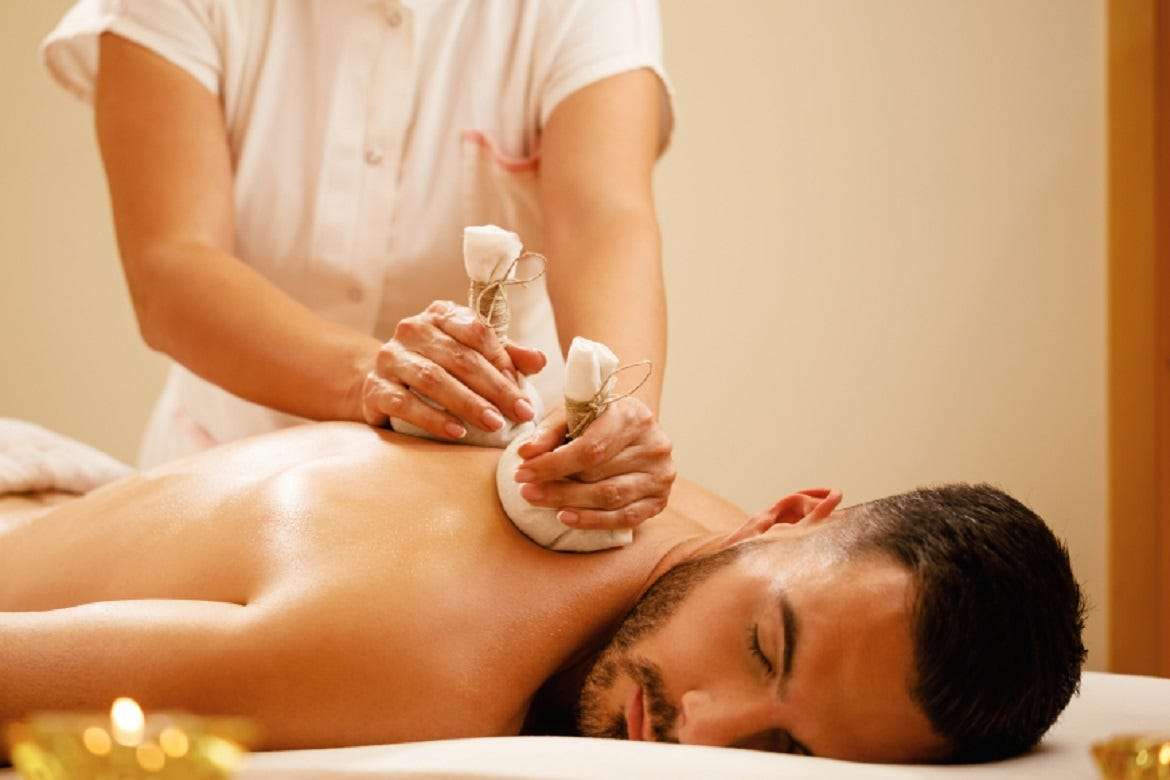

Abhyanga, an integral component of Ayurvedic healing, is a traditional massage technique that holds profound therapeutic significance. Derived from the Sanskrit words ‘abhi’ meaning ‘towards’ and ‘anga’ referring to ‘limbs,’ Abhyanga involves the rhythmic and synchronized application of warm herbal oils on the entire body.
This Ayurvedic massage serves multiple purposes, aiming to promote physical, mental, and spiritual well-being. The choice of oils is often determined by an individual’s dosha (Vata, Pitta, or Kapha) and specific health needs. The massage technique involves gentle yet firm strokes, stimulating energy channels (marma points) to enhance circulation, lymphatic drainage, and overall vitality.
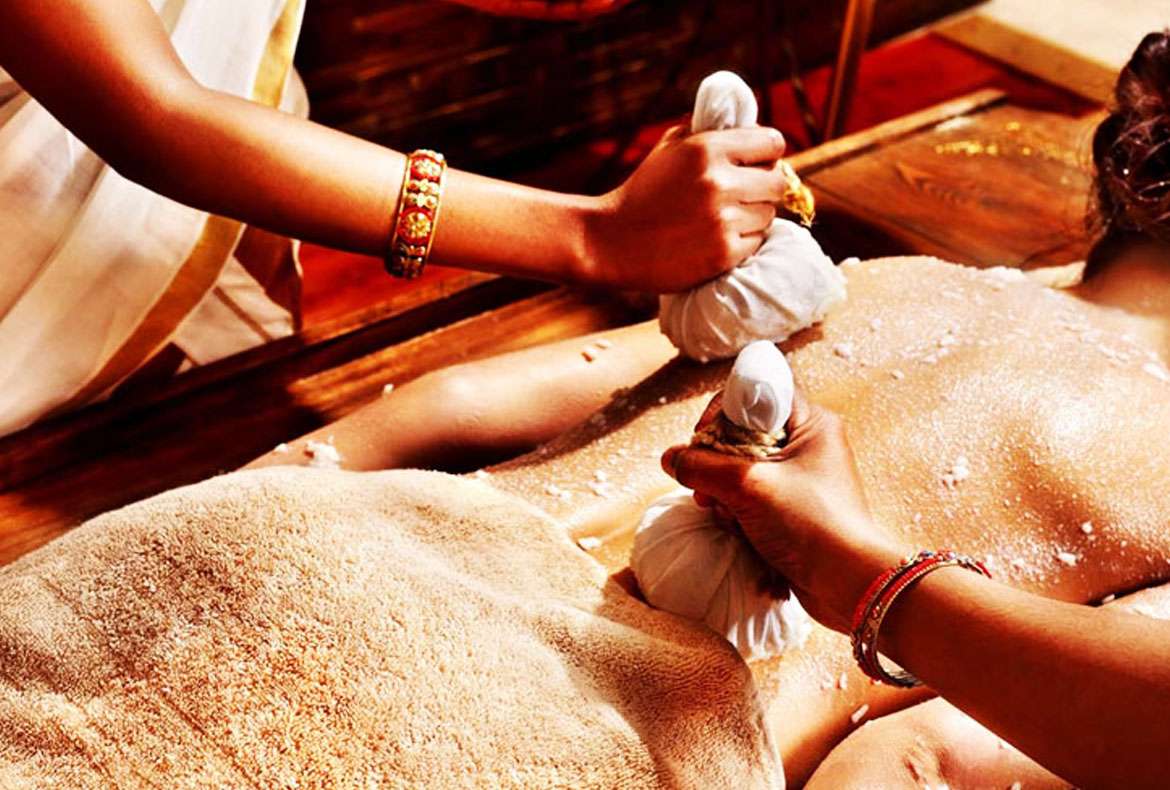
Njavara Kizhi, also known as Pizhichil, is a unique Ayurvedic therapy that involves massaging the body with warm medicated oil while simultaneously applying a bundle of cooked Njavara rice tied in muslin bags. This rejuvenating treatment, derived from the Sanskrit words ‘Njavara’ and ‘Kizhi’ meaning rice and poultice respectively, promotes muscle strength, nourishes the skin, and induces deep relaxation. The rice’s therapeutic properties combined with the continuous oil flow help detoxify the body, alleviate joint pain, and enhance overall vitality. Njavara Kizhi exemplifies Ayurveda’s holistic approach, blending medicinal herbs, warm oils, and specialized techniques for comprehensive well-being.

Matra Basti is a therapeutic procedure in Ayurveda that involves administering medicated enemas to address specific health issues. The term “Matra” refers to the quantity or dosage of the herbal concoction used in the enema. This Ayurvedic therapy aims to balance the doshas (Vata, Pitta, and Kapha) and cleanse the colon, promoting overall well-being. Matra Basti is tailored to individual needs, considering factors such as age, constitution, and the nature of the ailment. The procedure helps in detoxification, improving digestion, and alleviating conditions like constipation, joint disorders, and certain neurological issues. It is performed under the guidance of qualified Ayurvedic practitioners to ensure a safe and effective experience.
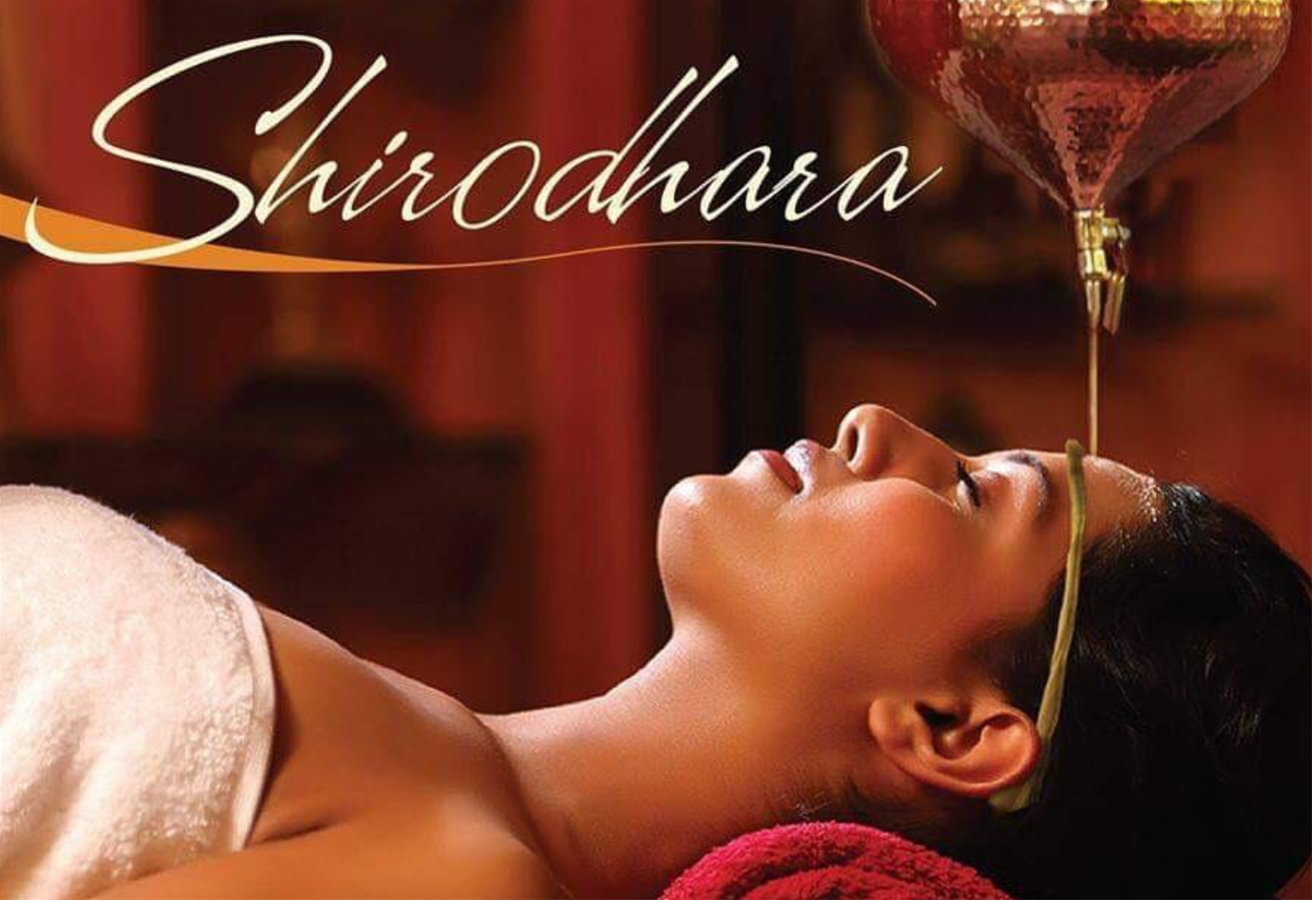
Shirodhara, a quintessential Ayurvedic therapy, involves a continuous stream of warm, herbal oil gently poured onto the forehead, specifically on the ‘third eye’ region. Derived from Sanskrit, where ‘Shiro’ means head and ‘Dhara’ means flow, this soothing treatment induces profound relaxation, balancing the nervous system. The rhythmic flow of oil stimulates the pineal gland, promoting mental clarity and tranquility. Shirodhara is renowned for alleviating stress, anxiety, and insomnia. Beyond its therapeutic benefits, this ancient practice fosters a deep sense of calm, aiding in overall well-being. Shirodhara exemplifies Ayurveda’s holistic approach to health by harmonizing mind, body, and spirit.
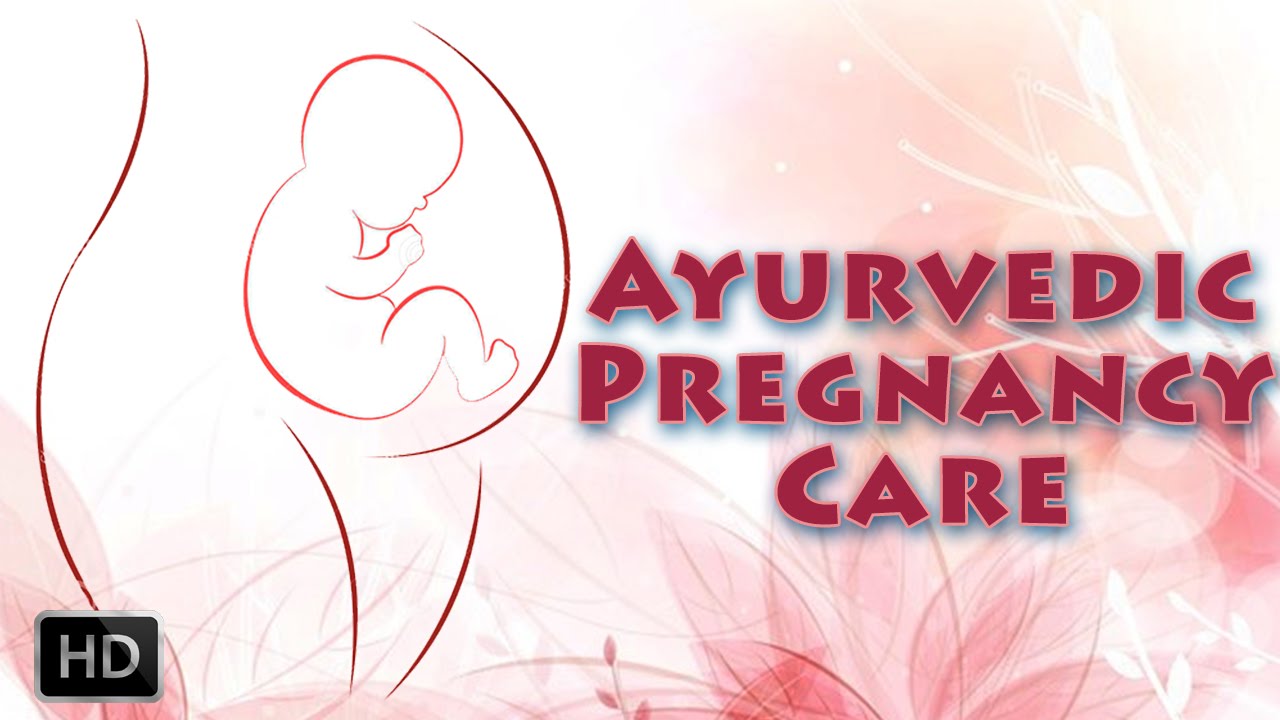
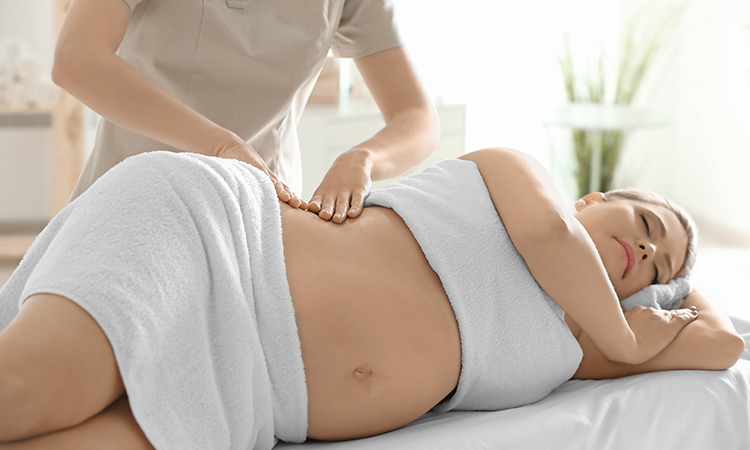
Abhyanga, an integral component of Ayurvedic healing, is a traditional massage technique that holds profound therapeutic significance. Derived from the Sanskrit words ‘abhi’ meaning ‘towards’ and ‘anga’ referring to ‘limbs,’ Abhyanga involves the rhythmic and synchronized application of warm herbal oils on the entire body.
This Ayurvedic massage serves multiple purposes, aiming to promote physical, mental, and spiritual well-being. The choice of oils is often determined by an individual’s dosha (Vata, Pitta, or Kapha) and specific health needs. The massage technique involves gentle yet firm strokes, stimulating energy channels (marma points) to enhance circulation, lymphatic drainage, and overall vitality.
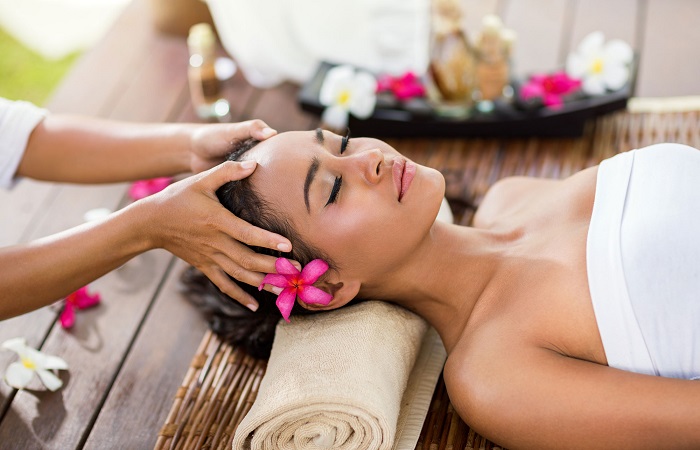
Shiro Abhyanga is a rejuvenating Ayurvedic therapy focused on the head and neck region. Translated as “head massage,” it involves the application of warm herbal oils to the scalp, hair, and neck. This therapeutic practice aims to balance the doshas, promote relaxation, and enhance mental clarity. Shiro Abhyanga not only nourishes the hair and scalp but also stimulates vital energy points, alleviating stress and promoting sound sleep. The rhythmic and soothing massage motions help release tension, improve blood circulation, and nurture the nervous system. This traditional Ayurvedic treatment is often recommended for enhancing overall well-being and mental rejuvenation.
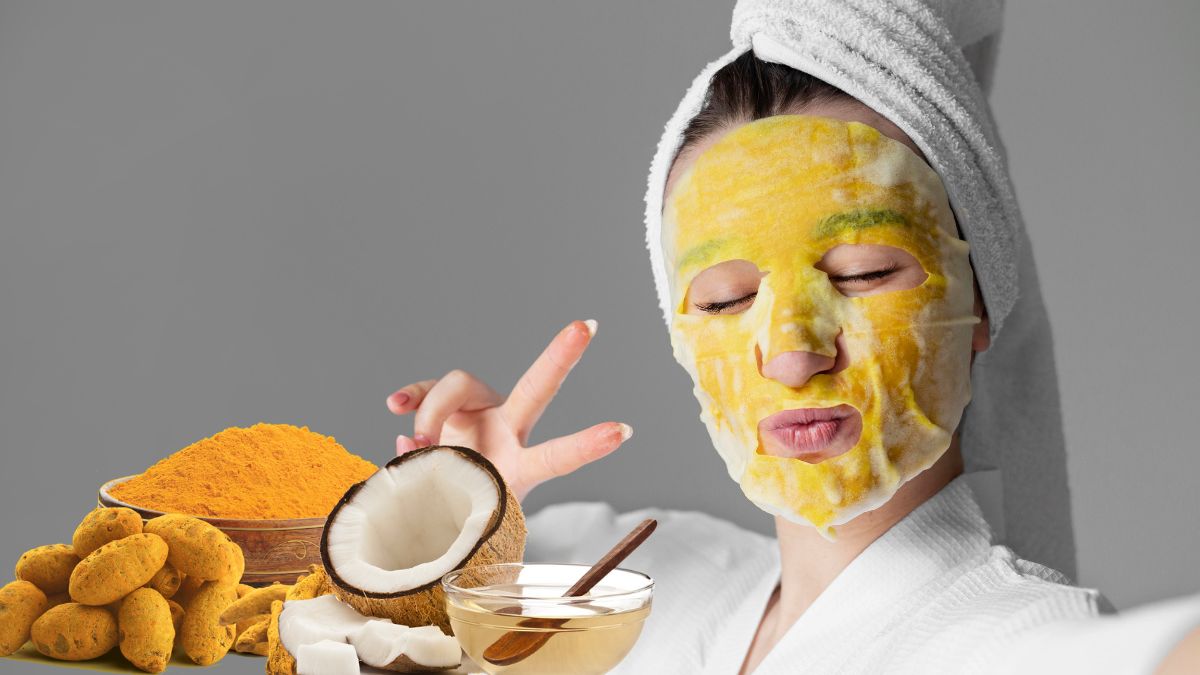
Lepa, an integral service in Ayurveda, encompasses the therapeutic application of herbal pastes or poultices to promote healing and balance in the body. Derived from ancient Ayurvedic texts, Lepa treatments aim to address various ailments by combining medicinal herbs, minerals, and natural substances in a specific formulation. These pastes, when applied topically, penetrate the skin to stimulate circulation, reduce inflammation, and detoxify the affected area. Lepa therapy is known for its efficacy in managing conditions like skin disorders, joint pain, and muscle injuries. Rooted in Ayurvedic principles, Lepa emphasizes personalized formulations to align with an individual’s unique constitution, ensuring holistic well-being.

Garbha Raksha in Ayurveda is a specialized service dedicated to the well-being of both mother and unborn child during pregnancy. Translating to “protecting the fetus,” Garbha Raksha focuses on nurturing a healthy pregnancy through a combination of personalized dietary guidance, herbal supplements, and lifestyle recommendations. Ayurvedic practitioners tailor their approach based on the mother’s constitution, addressing imbalances to optimize physical and mental health. This holistic approach aims to prevent complications, promote proper fetal development, and enhance the overall pregnancy experience. Garbha Raksha encapsulates the wisdom of Ayurveda to ensure a harmonious and balanced journey from conception to childbirth.
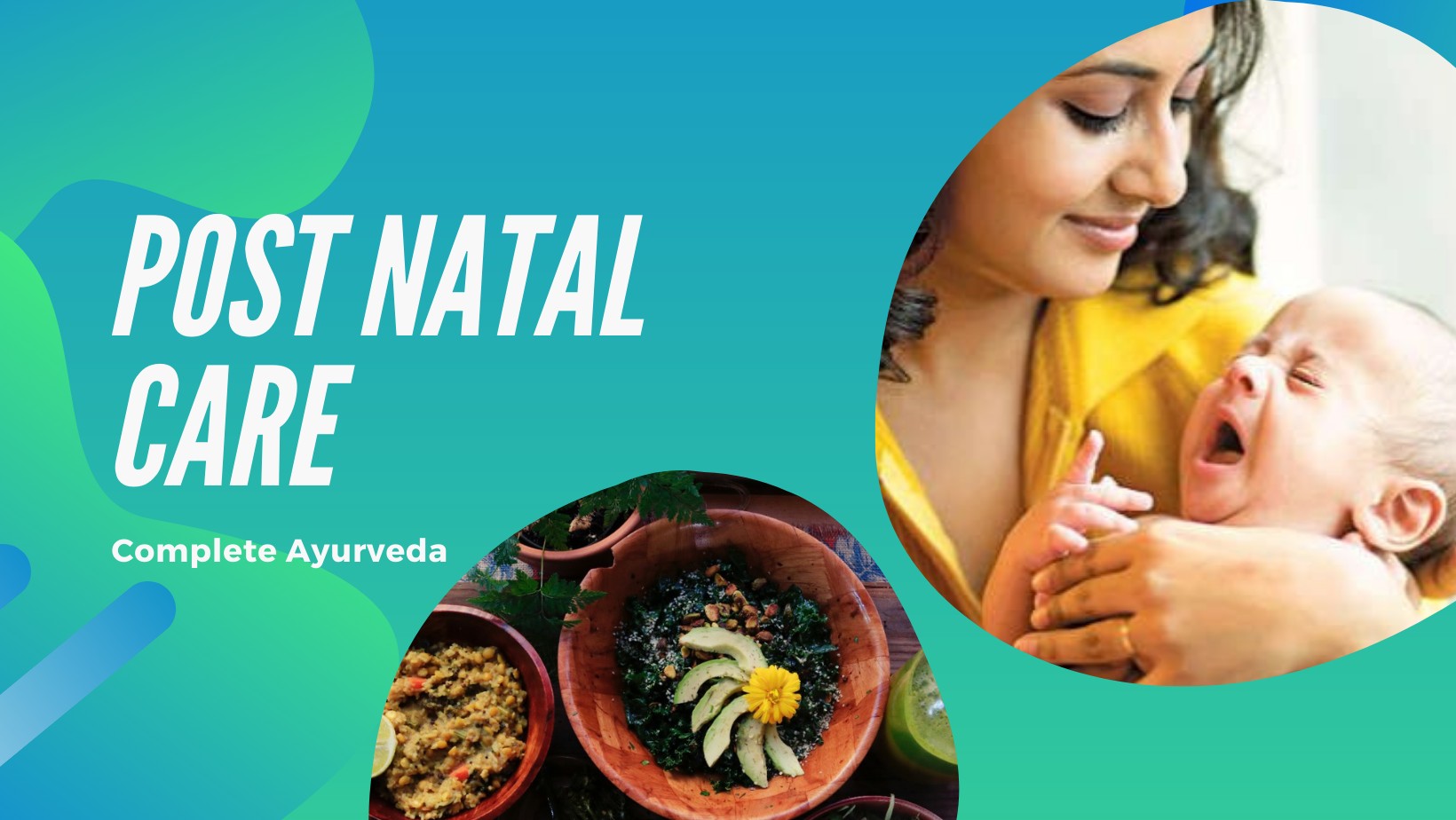
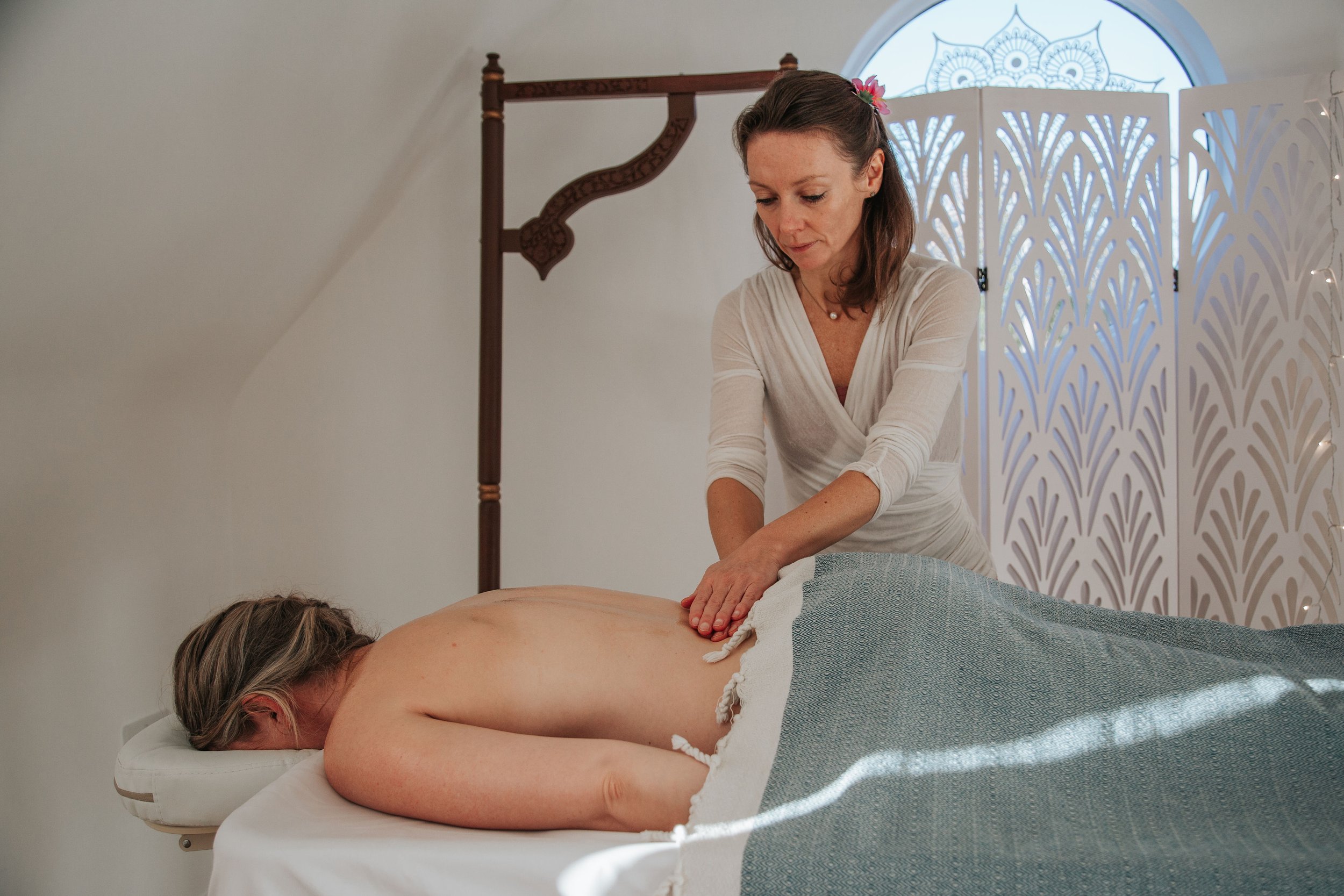
Abhyanga, an integral component of Ayurvedic healing, is a traditional massage technique that holds profound therapeutic significance. Derived from the Sanskrit words ‘abhi’ meaning ‘towards’ and ‘anga’ referring to ‘limbs,’ Abhyanga involves the rhythmic and synchronized application of warm herbal oils on the entire body.
This Ayurvedic massage serves multiple purposes, aiming to promote physical, mental, and spiritual well-being. The choice of oils is often determined by an individual’s dosha (Vata, Pitta, or Kapha) and specific health needs. The massage technique involves gentle yet firm strokes, stimulating energy channels (marma points) to enhance circulation, lymphatic drainage, and overall vitality.
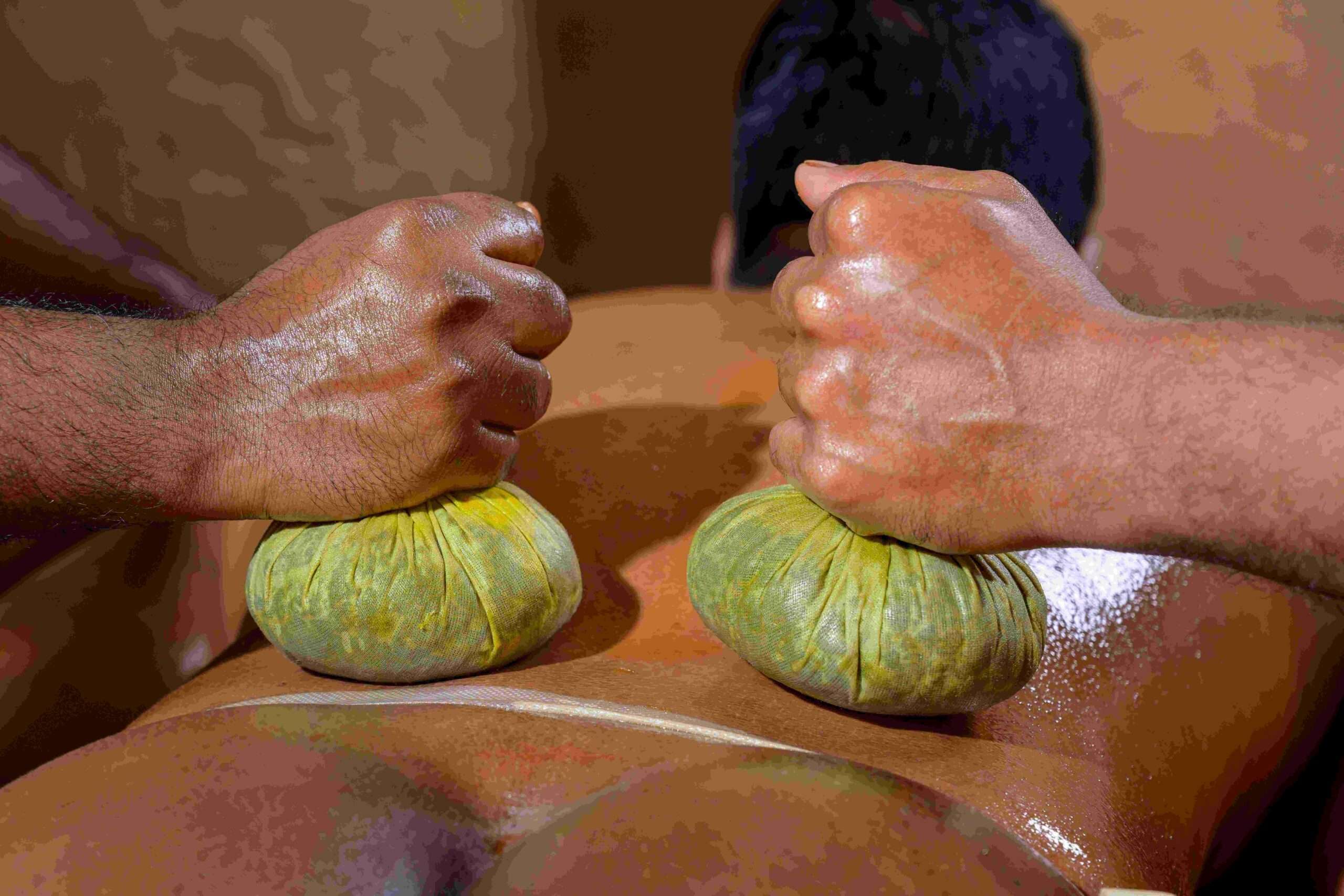
Ela Kizhi is a therapeutic service in Ayurveda that involves a unique form of poultice massage. This rejuvenating treatment utilizes heated herbal pouches, typically filled with a blend of medicinal leaves, powders, and rice. These pouches are systematically massaged over the body, promoting relaxation, improving circulation, and alleviating muscular tension. Ela Kizhi is particularly effective in addressing joint pain, arthritis, and various musculoskeletal disorders. The warmth and herbal properties of the poultices induce sweating, aiding in detoxification. This Ayurvedic therapy not only offers physical relief but also contributes to overall well-being by harmonizing the body’s energies and promoting a sense of tranquility.
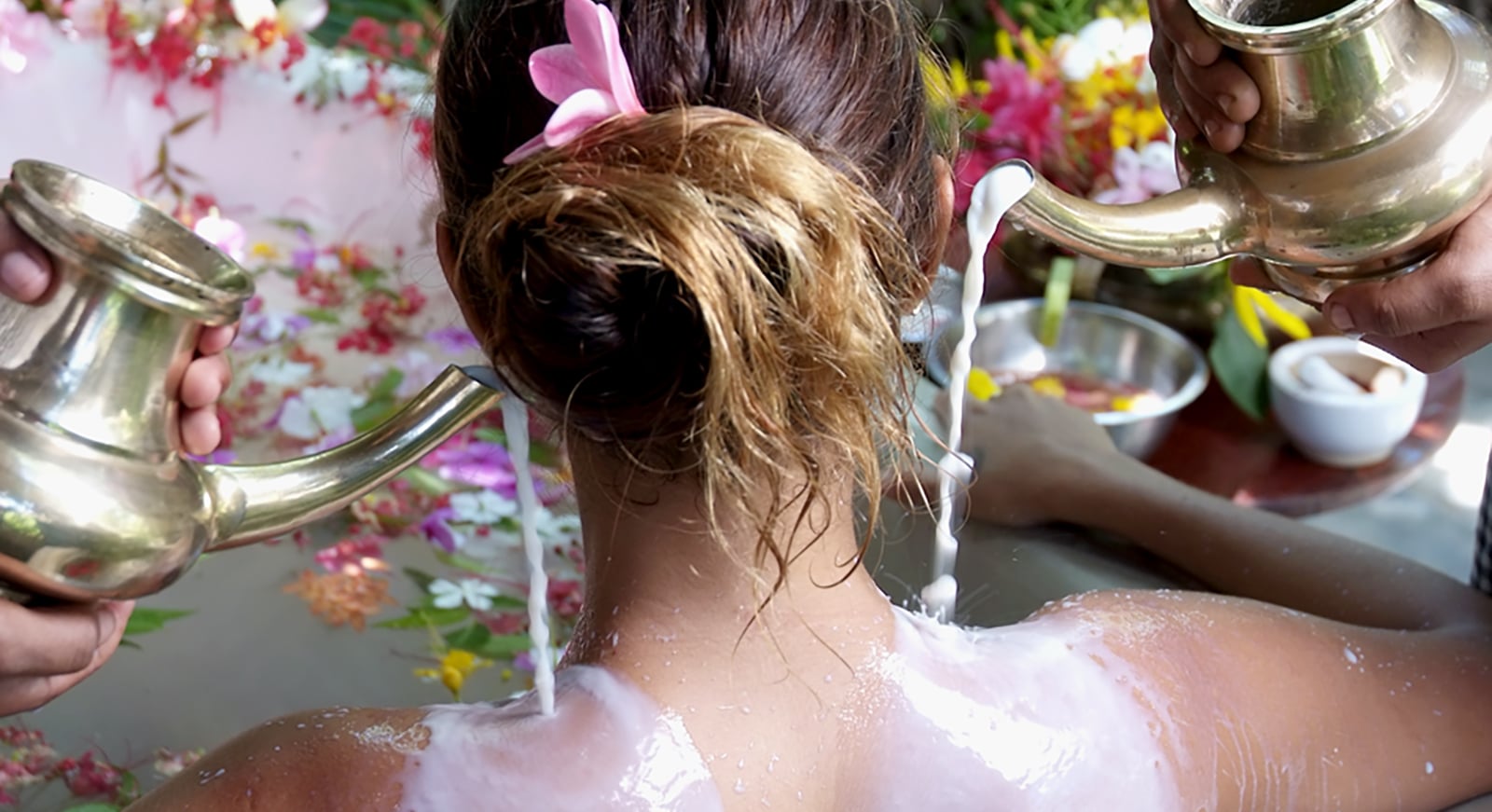
Vetu Snana, a traditional Ayurvedic therapy, involves a ritualistic and therapeutic oil bath designed to enhance physical and mental well-being. Conducted during specific seasons, it utilizes medicated oils, herbs, and aromatic substances tailored to an individual’s dosha (constitution). Before sunrise, the person undergoes a full-body oil application followed by exposure to gentle sunlight. This process stimulates the skin, promotes detoxification, and nourishes tissues. Vetu Snana is believed to strengthen the immune system, improve skin health, and balance doshas. Rooted in Ayurvedic principles, this ritual not only rejuvenates the body but also revitalizes the mind, promoting a holistic state of health.

Baby Massage, a cherished practice in Ayurveda, involves gentle, rhythmic strokes using herbal oils on an infant’s body. This ancient tradition supports the baby’s overall growth and development. The massage helps enhance circulation, aids digestion, and promotes restful sleep. Ayurvedic oils, chosen based on the baby’s constitution, nourish the skin and strengthen the muscles. This tender touch fosters a strong bond between parent and child while facilitating sensory stimulation. Regular Baby Massage in Ayurveda is believed to contribute to the baby’s physical and emotional well-being, ensuring a healthy start to life through the holistic principles of Ayurvedic care.
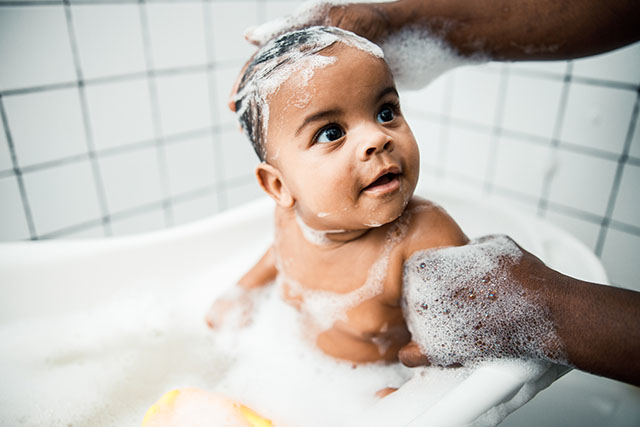
Baby Bath in Ayurveda is a gentle and nurturing ritual designed to promote the health and well-being of infants. Utilizing Ayurvedic principles, this bathing practice involves the use of mild, natural cleansers like herbal powders or pastes tailored to the baby’s dosha (constitution). The water temperature is carefully regulated to maintain balance, and Ayurvedic oils may be applied post-bath to moisturize and protect the baby’s delicate skin. This holistic approach not only cleanses the baby but also supports their physical and emotional development. Baby Bath in Ayurveda is a cherished tradition that emphasizes the importance of natural, personalized care for the youngest members of the family.

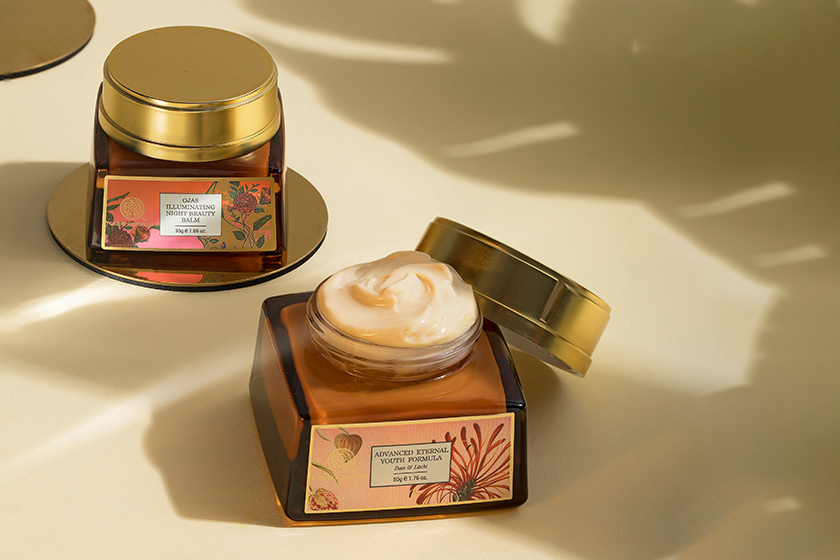
Varnya, an Ayurvedic beauty care service, focuses on enhancing skin complexion and radiance. Derived from the Sanskrit word “VarNa,” meaning color, this therapy utilizes natural ingredients and personalized formulations to promote healthy, glowing skin. Varnya therapies often include herbal facials, masks, and massages, tailored to individual doshas. Key ingredients like turmeric, sandalwood, and saffron are commonly employed for their skin-brightening properties. The treatment not only addresses pigmentation issues but also nourishes and rejuvenates the skin, promoting an even tone. Rooted in Ayurvedic principles, Varnya underscores the holistic approach of Ayurveda towards beauty, emphasizing inner well-being and external radiance.

Ayurvedic Facial, a rejuvenating therapy, integrates ancient wisdom with modern skincare. Tailored to individual doshas, this holistic treatment uses natural ingredients like herbal pastes, oils, and aromatic substances to cleanse, exfoliate, and nourish the skin. The facial massage stimulates energy points, promoting circulation and revitalizing facial muscles. Ayurvedic herbs like neem, turmeric, and aloe vera are often incorporated for their purifying and anti-inflammatory properties. Beyond cosmetic benefits, Ayurvedic Facial aims to balance doshas, addressing underlying imbalances that manifest on the skin. Rooted in Ayurvedic principles, this facial offers a harmonious blend of beauty and overall well-being, promoting a radiant complexion.
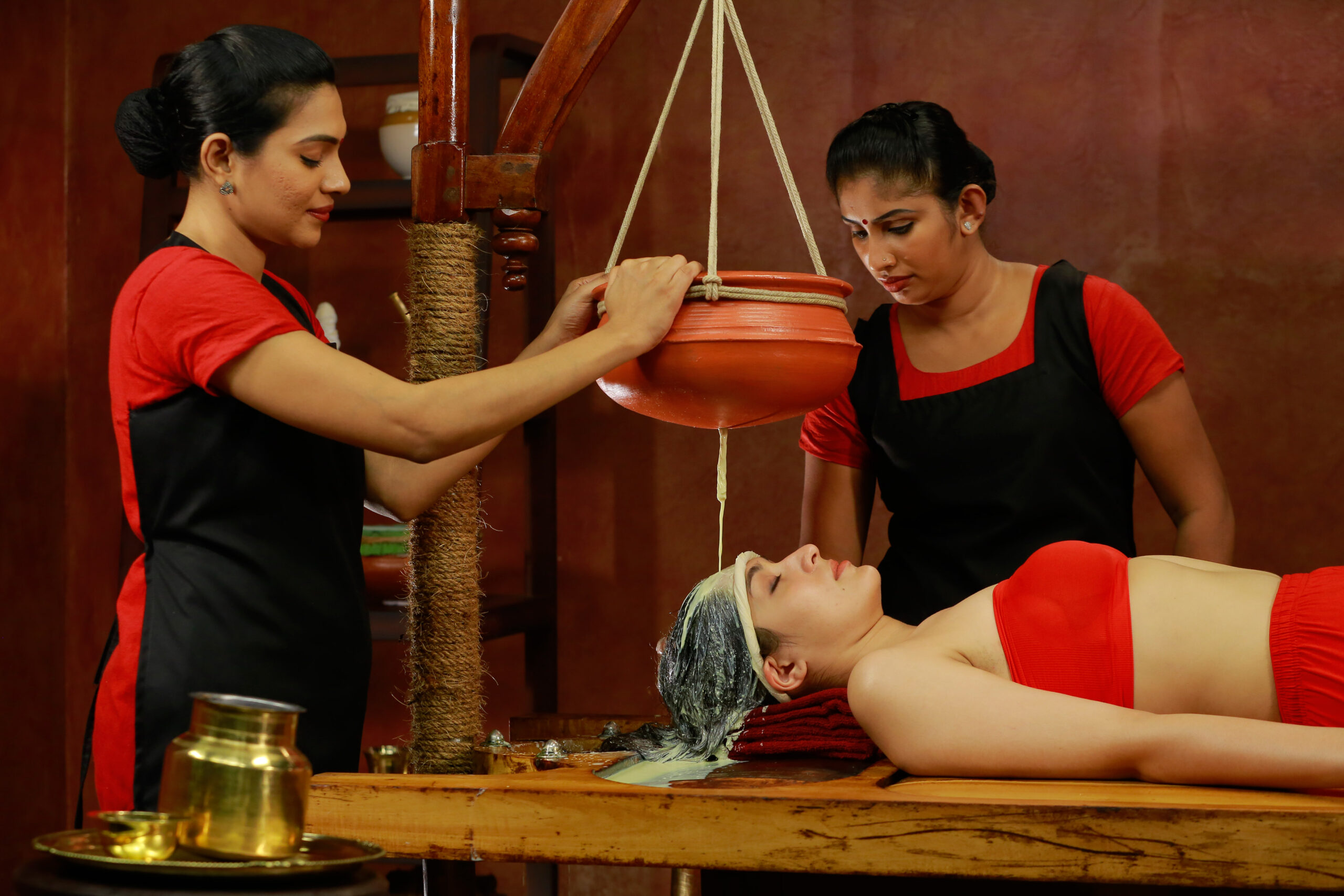
Shirodhara, a quintessential Ayurvedic therapy, involves a continuous stream of warm, herbal oil gently poured onto the forehead, specifically on the ‘third eye’ region. Derived from Sanskrit, where ‘Shiro’ means head and ‘Dhara’ means flow, this soothing treatment induces profound relaxation, balancing the nervous system. The rhythmic flow of oil stimulates the pineal gland, promoting mental clarity and tranquility. Shirodhara is renowned for alleviating stress, anxiety, and insomnia. Beyond its therapeutic benefits, this ancient practice fosters a deep sense of calm, aiding in overall well-being. Shirodhara exemplifies Ayurveda’s holistic approach to health by harmonizing mind, body, and spirit.

Experience the rejuvenating embrace of Ayurveda with our Hair Care service, a holistic approach to nurturing your locks. Rooted in ancient Indian wisdom, Ayurveda seeks to balance the body, mind, and spirit. Our skilled practitioners blend traditional herbal formulations, personalized consultations, and therapeutic techniques to address individual hair concerns. Tailored Ayurvedic treatments promote hair health by stimulating circulation, nourishing the scalp, and fortifying strands with natural ingredients like amla, bhringraj, and neem. Embrace the profound harmony of Ayurvedic rituals, unlocking the secrets of lush, vibrant hair. Elevate your self-care journey with our Hair Care service, where timeless traditions meet modern wellness.